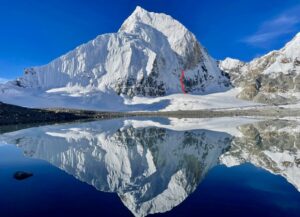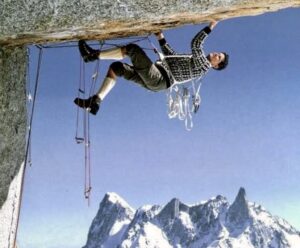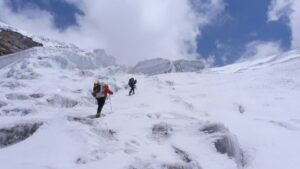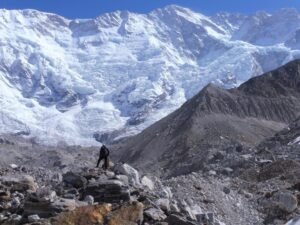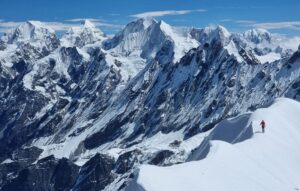Though we may never know the exact time, place, or origin of many traditions, every human discipline results from a flashpoint in our history. For modern mountaineering, that flashpoint occurred on August 8, 1786, atop the revered Mont Blanc.
The tallest massif in both the Alps range and Western Europe, Mont Blanc stands 4,807m above sea level and is home to some of the world’s most unrelenting alpine climbs, even by contemporary standards.
The climbers of today stand on the shoulders of giants, it seems — perhaps more palpably (and literally) than occupants of almost any other pursuit. We benefit from generations of experienced practitioners, literature, hands-on instruction — learning a technique or scaling a route in a fraction of the time they originally took.
Many of us receive bonified instruction in the safety of climbing gyms or at local crags. A litany of resources are accessible from the comfort of our own homes. To even attempt a proper homage to all those who blazed the trails before us is a nearly futile exercise. We can give thanks, sure, but mostly to the ether.
So, when the occasion to celebrate any particular feat for its contribution to our subcultural lineage comes about, why not seize it? In celebration of the 235th anniversary of Mont Blanc’s first ascent, we’d like to reflect a bit on the landmark event, its ascensionists, and what it all means to the awe-inspiring, humbling, wild tradition of mountaineering.

Aiguille du Midi peak near Mont Blanc. Photo: C. Pelle/Shutterstock
Key figures in Mont Blanc history
Horace-Benedict de Saussure
Three scientists are primarily credited with correctly identifying Mont Blanc as the highest peak in all of Western Europe: P. Martel (1742), Jean A. Deluc (1770), and Horace-Benedict de Saussure (1760). But it would remain a much-contested and unproven hypothesis for decades.
In 1760, 26 years before Mont Blanc’s first recorded ascent, Swiss naturalist Horace-Benedict de Saussure tried to summit the alpine massif — and to encourage climbers to beat him to it. De Saussure famously offered prize money to whoever claimed the first ascent.
More than two decades later, Chamonix physician Michel-Gabriel Paccard and his porter, Jacques Balmat, completed the task.
Michel-Gabriel Paccard and Jacques Balmat
Paccard was, in fact, a Chamonix native and physician with penchants for climbing and mountain survival. After many exploratory climbs and several failed attempts at summiting Mont Blanc, Paccard concluded that the most common approach (up the northwest buttress and over the Dome du Gouter) was likely not the best option. Instead, Paccard opted for an approach through the Valley of Snow.
Over the next three years, Paccard used a telescope to observe the Valley, charting changes in ice formations and avalanche activity. It is said that the doctor, though adventurous, was also likely driven by scientific pursuits. Although he believed Mont Blanc to be the tallest peak in the Alps, there was no proof at the time, and many doubted the veracity of the claim. Paccard intended to use scientific instruments while on the mountain to prove his theory.
Paccard hired a local guide, Jacques Balmat, for the endeavor up Mont Blanc.
Neither carried a rope or ice ax
The two Chamoniards set out during the last full-moon phase of summer, on the afternoon of August 7, 1786. Their packs contained blankets, food, and Paccard’s various scientific instruments. Neither carried a rope or an ice ax. The only aid equipment between them? One pair of crude, 3m-long poles.
After spending the night under a cluster of rocks on the Montagne de la Cote, Paccard and Balmat set out at dawn on August 8. The men relied heavily on the 3m poles, using one each to shimmy across chasms and straddle over collapsing fissures during a five-hour traverse of an infamous section, the Jonction.
Eleven hours later, Paccard and Balmat arrived at the Valley of Snow’s upper region, the previously unexplored Grand Plateau. With another 900m to go until the summit, the two plowed on through torrential winds and exposure. In the early evening of August 8, 1786, Paccard and Balmat reached the top of Mont Blanc, where Paccard quickly recorded barometric pressure and temperature readings before the two journeyed back down to Chamonix.

Mont Blanc massif. Photo: Shutterstock
In his detailed recounting of the ascent, Eric Shipton notes:
“Judged by sheer physical effort alone, the first ascent of Mont Blanc was a remarkable performance. Paccard and Balmat had climbed some 8,200 feet to the summit and back in a single day, a feat rarely accomplished today even on well-known ground. Theirs was an astounding achievement of courage and determination, one of the greatest in the annals of mountaineering. It was accomplished by men who were not only on unexplored ground, but on a route that all the guides believed to be impossible…They lacked the most rudimentary items of climbing equipment, and they were dealing with an element that was little understood and still greatly feared.”
Just one year later, Horace-Benedict de Saussure himself summited Mont Blanc, accompanied by his porter, Jean-Laurent Jordaney.
In 1809, Henriette d’Angeville would become the first woman to summit Mont Blanc (technically the second woman overall. She is quoted saying that she was the first woman ascensionist on Mont Blanc “still capable of remembering her impressions”). And d’Angeville was just one among a handful of courageous 19th-century female alpinists to take on the Alps.

Statute of Mont Blanc’s first ascensionist, Michel-Gabriel Paccard. Chamonix, France. Photo: P. Stein/Shutterstock
The Legacy
The feat of Mont Blanc drew climbers, explorers, and adventurists to the Alps over the next few decades. This surge in alpine tourism prompted rapid growth in portering companies and mountain guide schools throughout Alps-adjacent French, Italian, and Swiss settlements.
In the mid-1800s, the Alps experienced a particular uptick in British-led expeditions, with a focus on the massifs of Switzerland. During that time, British climbers and Alpsian porters would claim numerous first ascents in the vast range, including Edward Whymper’s capture of the Matterhorn (4,478m) in 1865.
Books have been written attempting to chart the dissemination of mountaineering, its disciples, methods, and various ways it has spread. Today, the subject’s complexity is immense; history harbors incredible triumphs, excruciating tragedies, and even bouts of mediocrity. But for all of its vastness and many evolutions, mountaineering began when two men approached the seemingly impossible and summited it all in a day at Mont Blanc.

